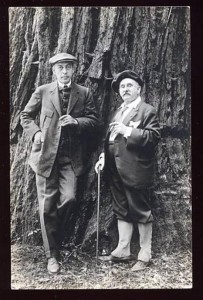Sir Henry Heyman
Values Codes I – H – E – L – P
Henry Heyman was born in Oakland, California in 1855.
The Heymans were among the first Jewish settlers of Oakland and operated a stove store.
Henry Heyman’s talent for the violin was apparent at an early age.
In 1870, he left for Europe after completing music and general studies at Oakland College and what became the University of California at Berkeley.
He attended the Royal Conservatory in Leipzig, where his celebrated teachers included Ferdinand David.
Heyman received the Conservatory’s distinguished Mendelssohn Scholarship, and following graduation accepted a position as quartet leader and solo violinist to the Duchess of Bernburg.
San Francisco
Upon returning to San Francisco in 1877, the slightly eccentric Henry Heyman became one of the city’s most popular classical musicians.
He was a principle founder and concertmaster of the Philharmonic Society Orchestra (est. 1881).
He also organized the Henry Heyman String Quartet.
His orchestral and chamber performances attracted large crowds and garnered critical acclaim.
As one reporter put it, “The success of any entertainment under Heyman’s direction is proverbial.”
Henry Heyman was also a much-sought-after violin teacher. He took the role very seriously and devoted much attention to his students, several of whom became star performers in their own right.
Civic
In addition to his musical activities, Henry Heyman involved himself in many social enterprises and charitable causes.
He was a prominent member of the San Francisco Art Association and School of Design.
For the celebration of the 800th anniversary of the University of Bologna, he was appointed as a member of the International Exposition of Music.
Heyman earned the friendship of numerous European celebrities.
Camille Saint-Saëns even dedicated his Élégie op. 143 in D major to him, citing the “infinite kindness” he bestowed upon him during his stay in California (May-July 1915).
Most memorably, King Kalakaua of Hawaii hosted Henry Heyman as Royal Hawaiian Solo Violinist and made him a Knight of the Royal Order of the Star of Oceania — the oldest decoration of the Hawaiian Kingdom.
Among the comments written about Henry Heyman during his lifetime, two are particularly illustrative.
The first, published in The Bay of San Francisco (1892), notes that Heyman:
“has endeared himself to the public and his friends not only by his courteous and refined manners, his constant readiness to help his colleagues, but also by zealous work in the cause of music and sweet charity, which gives him the very highest standing.”
The second, printed in The Violinist of January 1917, describes a party scene:
“A most unique honor was shown Sir Henry Heyman, violinist, by the Bohemian Club of this city. I nvited to a dinner at the club on his birthday, he entered the room to behold an impersonation of himself, surrounded by Paderewski, Saint-Saëns, Leoncavallo, David Bispham, etc., etc. It was a masquerade of notables, which had been inspired by the fact that Sir Henry had banqueted so many of them in that very room.”
Sir Henry Heyman died in 1924 at Hotel Paso Robles in Paso Robles, California, after suffering a heart attack.
“Sir Henry belonged to a very rare and select family of gentlemen who became famous because of the attention, courtesy and pleasure they bestow upon those with whom they come into contact. If pioneering means something in the growth of a city’s musical life, then Sir Henry is entitled to respect and esteem….He laid the foundation to many a career among now well-known violinists of San Francisco, who, in turn, are training future artists.”
— Emanu-El, April 4, 1924
Source
- William M. Kramer and Norton B. Stern, “Sir Henry Heyman: San Francisco’s Noble Musician,” Western States Jewish History 18/4.
Jonathan Friedmann is curator of this Sir Henry Heyman exhibit.

